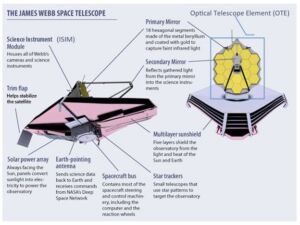
Credit: NASA
This content was written by Dillon Connelly from the Space Science Institute
Celebrate the first images of NASA’s James Webb Space Telescope with this featured activity: NASA’s James Webb Space Telescope
In this activity, you and your patrons will assemble a paper model of the James Webb Space Telescope. The model allows you to assemble the JWST from its three main elements. Facilitate as an in-person program at your library or a Take & Make activity.
Time to complete: 15-30 minutes
Ages: Upper Elementary, Middle, High School, Family
Modification and Preparation List
Total Cost: cost of printing and assembly materials
Fundamental Space Science Concepts – NASA’s James Webb Space Telescope relates to the James Webb Space Telescope’s First Images:
The James Webb Space Telescope is the most advanced telescope that has ever been launched into space. Its instruments will allow humanity to see deeper into the history of the universe than ever before. It took two decades of design and testing to get JWST to its final orbit around the sun. Not only must each instrument and element of JWST be precision engineered to last the lifetime of the mission, the entire telescope needed to fold up into a compact package small enough to fit on the Ariane 5 rocket that carried it to its final destination.
JWST’s body is made of three main elements:
- The Integrated Science Instrument Module (ISIM)
- The Optical Telescope Element (OTE)
- The Spacecraft Element (consisting of the Spacecraft Bus and the Sunshield)
The Integrated Science Instrument Module (ISIM) is the main payload of JWST and houses the telescope’s four main scientific instruments: the Near Infrared Camera (NIRCam) which acts as JWST’s primary imaging instrument that will detect light from some of the earliest stars and galaxies in the universe, the Near Infrared Spectrograph (NIRSpec) that analyzes the physical and chemical properties of distant celestial objects, the Mid-Infrared Instrument (MIRI) that will use its combined camera and spectrograph to detect exoplanets as well as analyze their physical and chemical components, and the Fine Guidance Sensor/Near Infrared Imager and Slitless Spectrograph (FGS/NIRISS) that helps aim the telescope and detect light anomalies that indicate an exoplanet orbiting a star or light being warped by the gravity of clustered galaxies. Any excess heat produced by JWST could interfere with its instruments detecting infrared and near infrared light, the ISIM also contains the complex cooling system that keeps the scientific payload at temperatures as low as 7 Kelvin (-447.1°F/-266.15°C), just 12.57°F/7.0°C above the temperature at which all thermodynamic energy disappears known as absolute zero.
The Optical Telescope Element (OTE) consists of JWST’s three imaging mirrors, a fourth steering mirror that works in conjunction with control systems on the spacecraft element, and the structures that cool and support these mirrors. The primary imaging mirror is actually eighteen hexagonal mirror segments kept in alignment by tiny motors called actuators that allow the segments to make motions less than 1/10000th the width of a human hair. Light collected by the primary mirror array is then reflected onto the secondary and tertiary mirrors, which focus and refine the light captured by the primary mirror array before being delivered to the instruments housed in the ISIM.
The optical and scientific instruments on the Integrated Science Instrument Module and the Optical Telescope Element are supported and kept in orbit by the JWST’s spacecraft element. The largest part of the spacecraft element is the five-layer sunshield with an area approximately the size of a tennis court. The sunshield’s aluminum-coated layers reflect light from the sun away from the temperature sensitive science and optical instruments on the “dark side” of JWST. The spacecraft element also contains the spacecraft bus. The spacecraft bus contains the systems that keep JWST in orbit and transmitting data back to Earth. These systems include the electrical system that powers JWST by converting solar energy to electricity, the processors that act as JWST’s “brain,” antennae that allow it to transmit data back to Earth, and the propulsion and control systems that keep JWST in its orbit around Lagrange point 2 nearly one million miles from where it was first launched. JWST even has a small trip flap that acts like a sail on a sailboat to compensate for the pressure of radiation exerted on JWST from the sun.
Resources for you to use and share with patrons:
This video walks you through making the JWST paper model.
Elements of Webb Playlist on YouTube
This series of short videos explore the elements like gold, beryllium, and silicon that are used in JWST’s various parts and instruments.
How Do Space Telescopes Break Down Light?
This short video from the Space Telescope Science Institute describes how space telescopes like JWST capture images and analyze the light from distant objects at the same time.
The Insane Engineering of James Webb Telescope
This episode of YouTube series Real Engineering goes in depth on the engineering behind JWST’s many elements and the astronomical realties that require such precision engineering.
Discover more activities in the Look Up! First Image Clearinghouse Collection




Leave A Comment